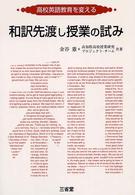- ホーム
- > 洋書
- > 英文書
- > Science / Mathematics
Full Description
Quantum physics provides the concepts and their mathematical formalization that lend themselves to describe important properties of biological networks topology, such as vulnerability to external stress and their dynamic response to changing physiological conditions. A theory of networks enhanced with mathematical concepts and tools of quantum physics opens a new area of biological physics, the one of systems biological physics.
Contents
TABLE OF CONTENTS
Quantum Mechanics in Biology
General Definitions
The Time-independent Schrödinger Equation
Time-dependent Schrödinger Equation
Transition Probability Per Unit of Time
Quantum Coherence and Entanglement
Quantum Interference
Quantum Effects in Biology
Statistical Physics in Biology
Why Statistical Physics in Biology?
Markov Processes
The Chemical Master Equation
Chemical Master Equation and Curse of Dimensionality
Discrete Approach to Chemical Kinetics
Stochastic Simulation Algorithm
An Example of Real Enzymatic Reactions Simulated with Gillespie Algorithm
Graph Theory and Physics Meet Network Biology
Physics at the Birth of Network Biology
Mutual Information-Based Network Inference
Thermodynamics Applications in Biological Network Analysis
Electronic Physics Applications in Network Analysis
Assessment of Network Inference Methods and the Issue of Generation of Gold-Standard Data
Network Biology is Transformed by Physics
Applied Descriptors for Complexity and Centrality to Network Biology
Network Theory
Measures for Network Complexity and Centrality
Comparative Network Analysis
Applications
Perspectives
Systems Theory and Quantum Physics
Various Recapitulation Exercises
References








